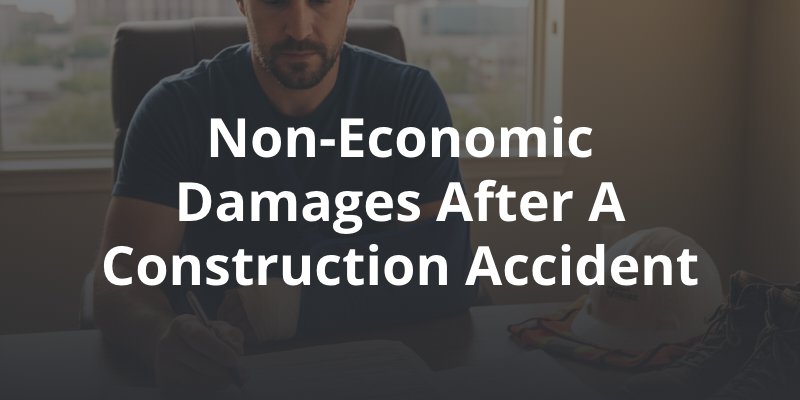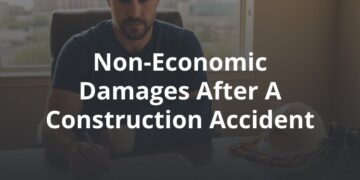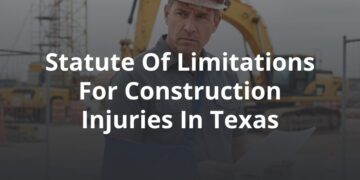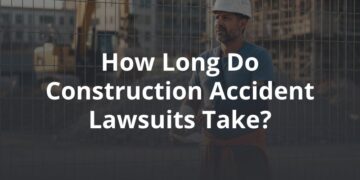
Construction jobs are some of the most dangerous in Texas, with numerous accidents, injuries, and worker deaths reported each year. If a construction accident is caused by someone else’s negligence or lack of proper care, such as an unsafe work environment, an Austin construction accident lawyer can help the injured worker recover financial compensation for related losses. Depending on the case, this could include non-economic damages.
What Are Non-Economic Damages?
Non-economic damages are a type of compensatory damage award available in many personal injury claims in Texas. Compensatory damages are designed to compensate an injured accident victim to make him or her whole again after a preventable accident. There are economic and non-economic damages.
Economic damages are the financial losses sustained by the victim from the construction accident, such as medical bills and property damage. Non-economic damages refer to the intangible effects suffered by the victim because of the accident and injury. They are also referred to as general damages or “pain and suffering.”
Common Types of Non-Economic Damages in Construction Injury Cases
A construction site accident can be frightening, traumatic and painful. As an injured worker, you may have suffered various types of mental, physical and emotional trauma because of the accident and your injuries. Non-economic damages attempt to make up for these intangible losses.
Common types include:
- Physical pain and suffering
- Chronic pain
- Emotional harm or distress
- Mental anguish
- Psychological trauma
- Post-traumatic stress disorder (PTSD)
- Depression or anxiety
- Inconvenience
- Loss of enjoyment or quality of life
- Loss of independence
- Scarring, disfigurement or disability
- Loss of consortium (for family members)
- Grief or mourning
Any negative or adverse outcome of your construction accident in Texas that is not monetary in nature could be listed as a non-economic damage for the purposes of seeking financial compensation.
How Are Non-Economic Damages Calculated?
When economic damages are calculated for the purposes of a construction accident settlement or judgment award, hard numbers are used from relevant bills, financial documents and expense receipts. When it comes to calculating non-economic damages, however, the information used is more subjective.
Insurance companies typically have their own protocols for calculating non-economic damage awards. If you are seeking workers’ compensation, note that pain and suffering damages are not available. If you have filed a claim outside of the workers’ comp system, the insurance company may use an equation of its own.
Do not accept a settlement without bringing it to an attorney first to confirm that the amount is fair and reasonable. If your construction accident case goes to court, a jury does not have to use any specific calculation method. The jurors can agree upon any amount they believe is fair after listening to the facts of the case. However, two main equations are often used.
| Calculation Method | How It Works | Example |
|---|---|---|
| Multiplier Method | Multiplies the total economic damages by a number (typically 1.5–5) that reflects the severity of the injury | Economic damages: $200,000 × Multiplier: 4 → Non-economic damages: $800,000; Total: $1,000,000 |
| Per Diem Method | Assigns a daily amount (often the victim’s daily wage) for each day of pain and suffering | Daily amount: $200 × 90 days of expected pain → Non-economic damages: $18,000 |
The Multiplier Method
The most common formula, especially when a construction worker’s injuries are severe or catastrophic, is the Multiplier Method. With this method, the total amount of the plaintiff’s economic damages is multiplied by a number between 1.5 and 5 that is representative of the gravity of the victim’s injuries.
For example, if you are awarded $200,000 for your economic damages and a jury assigns a multiplier of 4 for a severe or debilitating injury, the amount recommended in non-economic damages would be $800,000, bringing the total judgment award to $1 million.
The Per Diem Method
The Multiplier Method is used most often when a construction accident victim has long-term or lifelong pain and suffering. In cases where the plaintiff is expected to make a full recovery, the Per Diem Method is used more often.
This equation multiplies a daily amount (typically equivalent to the construction worker’s daily wage) by the number of days he or she will foreseeably experience pain and suffering. If a full recovery is anticipated within approximately 90 days, for example, and a construction worker’s daily wage prior to the accident was $200, the amount awarded and pain-and-suffering damages would be around $18,000.
What Factors Impact the Value of Non-Economic Damage Awards in Texas?
Certain factors are typically considered when calculating what is a “fair and reasonable amount” in pain and suffering damages during a construction accident claim. These include:
- The severity, extent and gravity of the victim’s injuries
- The amount of associated pain and suffering
- How long it will take the victim to reach his or her point of maximum medical improvement
- The daily struggles of living with a long-term injury or disability
- Changes in the victim’s daily life and quality of living
- Any mental health conditions diagnosed after the accident
- The amount of insurance coverage available or the defendant’s ability to pay
- Whether the case reaches a settlement or goes to trial
Every construction accident case in Texas is unique. Since each individual will experience a different amount of pain and suffering, non-economic damages can have vastly different values. The most accurate way to determine your case value is by consulting with an experienced work injury lawyer.

150+ years experience500+ 5 star reviews24/7 assistance
Top Personal Injury & Accident Lawyers
Call an Austin personal injury lawyer at FVF Law Firm – Injury & Wrongful Death Lawyers for a free consultation at (512) 910-7536.
How Can an Injury Attorney Help?
Achieving a fair pain and suffering award after a construction accident in Texas comes down to the story that is told. Hiring a skilled and experienced Austin personal injury attorney can put you in the best position possible to prove your non-economic damages and pursue a fair settlement or judgment award.
A lawyer can help you gather evidence to prove pain and suffering, but the greatest value will come from the attorney’s storytelling capabilities. If the case goes to trial in Texas, it is the jury who will decide what is a “fair” amount in pain and suffering. Your lawyer can help a jury really understand the effects that an injury has had on your life.
A good lawyer can describe in detail how the injury will impact your quality of life, ability to engage in your favorite activities and enjoy time with loved ones, capacity to maintain gainful employment, and any effects on your mental health and self-esteem. Building a powerful narrative around the evidence can make an impact on an insurance company or jury to maximize the non-economic damages awarded.
Learn more about your individual construction accident claim during a cost-free, pressure-free case evaluation at FVF Law Firm. We have over 100 years of combined legal experience and know how to recover the compensation our clients need.





